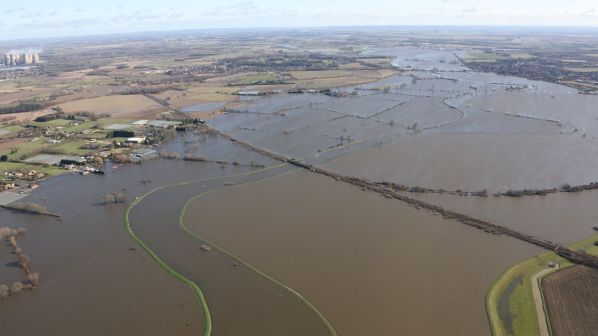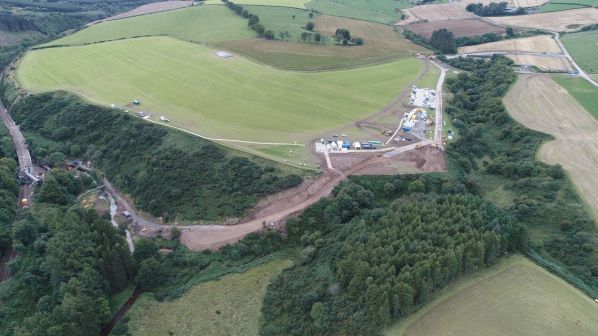The report highlights the need for an increased focus on deploying technology across the network to predict failures as well as investments in improved local forecasting to facilitate decision making for imminent weather events.
The report says that the factors contributing to the derailment at Carmont on August 12, in which three people died after an InterCity 7 HST struck a pile of washed-out rock and gravel, are complex, and the first priority since the incident has been to establish additional precautionary measures.
This includes reviewing communication processes to provide a consistent network-wide response to extreme rainfall-related events by drivers, railway staff, signallers, and control centres. This work resulted in NR identifying the need to strengthen industry rules to provide instructions on train operation during extreme weather in the event of reports of water build-up or damage to structures above or below the railway. In addition, operating instructions have been revised to clarify train operating principles during extreme weather. A risk alert status aligned with weather forecasts and infrastructure risks to determine the appropriate response has also been introduced.
NR says it has identified 584 sites across Britain’s 16,000km network with similar characteristics to Carmont. In-house engineers and specialist contractors undertook inspections of these sites, which are supplemented by aerial surveys. No sites have been found to require emergency intervention with 1% of sites found to have defects that have deteriorated and require action sooner than originally planned.
NR says an earthworks management taskforce led by Lord Robert Mair will review the infrastructure manager’s capability to better understand, manage, and improve all aspects of earthworks safety. The task force will consider current skills and competence, look at what can be learned from other organisations and countries, and the use and deployment of new technologies.
NR says it has already installed telemetry solutions at more than 200 locations and recently completed work applying machine learning to enhance earthworks risk hazard scoring. It is now working on developing and trialling new earthwork monitoring systems, including surface ‘tilt meter’ technology to warn of sudden earthwork movement. It says these processes increasingly harness aerial derived laser survey using helicopters and drones, train-borne survey, and asset monitoring using telemetry, which is improving insight on the changing state of assets and supporting the provision of early warning alerts.
NR says that it is reviewing the speed of deployment of on-the-shelf geotechnical monitoring technology to identify opportunities to accelerate its existing programme.

Weather services
In addition, NR is enhancing its weather services website, which is used by all operational controls, maintenance delivery, train operators and freight operators. A new tool providing improved alerts for convective storm events is being accelerated and will be trialled over the coming months. NR is also exploring the potential benefits of introducing a real-time weather alert system to improve understanding of localised risks from rainfall to infrastructure and operations. A review of NR’s weather forecasting information is also underway as part of weather advisory task force led by Dame Julia Slingo.
NR adds that it will work with other agencies, such as Highways England, the Civil Aviation Authority, Transport for London and other infrastructure bodies in Scotland to compare approaches to the issues that have emerged from Carmont. It is also reviewing international benchmarks and practices that might be applicable to Britain, and working closely with the Railway Safety and Standards Board (RSSB) on its research into derailment containment measures.
In the long-term, NR says its forthcoming Environmental Sustainability Strategy will outline ambitions for climate change adaptation and a roadmap to 2040, which looks to embed long-term forward-looking adaptation into the core of the infrastructure manager’s activities. One of the key ambitions is the development of local climate change adaptation strategies and investment plans for each railway corridor that will map out NR’s objectives to 2050.
Increasing investment
NR is investing £1.274bn to maintain and renew earthworks during its current five-year funding cycle, Control Period 6, which will run until 2024. This figure is 20% more than the £952m invested in CP5 (2014-2019) and more than double the £550m investment in CP4 (2009-2014). There is also the potential to use £185m of risk funds as further needs emerge while reprioritisation of activities by regions has added £210m to base plans due to the need to respond to weather-related events being greater than forecast.
NR says work in CP6 is currently ahead of schedule in terms of completion and expenditure. An £80m investment is expected during the funding period to design and develop projects for completion in CP7, during which investment on enhancing earthworks and drainage was expected to rise by £300-500m before Carmont. NR says further work is taking place to analyse the rate of change to forecast medium and long-term needs.
The report says that the risk to railway infrastructure posed by climate change is already being felt, and a progressively rising investment accompanied by transformational change in how the network is managed and technology is deployed is required. The report says ‘good’ management of climate change risk involves improved on the ground resilience which will come at significant cost and will take many years to achieve.
“Whilst our planning for climate change adaptation is well advanced (as recognised by the Committee on Climate Change in their 2019 Progress Report), our key challenge will be implementing these plans and improving resilience on the ground,” the report says. “Our challenges are shared by other operators of historical infrastructure.”
Indeed, the Environment Agency’s estimate of accelerated deterioration of 30-60% of assets are consistent with the changes NR is forecasting for CP7 but the report says these have arisen much sooner than anticipated.
“We are all aware that we are increasingly seeing more incidents of severe weather and, as the report published today shows, earthworks and drainage infrastructure - some of which are more than 150-years-old - prove to be a real challenge as the country experiences more heavy rainfall and flooding,” says NR chief executive, Mr Andrew Haines.
“Our railway is one of the safest in Europe and tragic accidents are incredibly rare, but something went wrong on August 12 near Stonehaven, and it is a stark reminder that we must never take safety for granted. We are improving and accelerating our resilience work and will do everything we can to minimise the impact of weather on the safety and reliability of the railway as our climate continues to change.”
Final report
The interim report is set to be followed by a final report, which will be published “in due course.” The Department for Transport says this will provide greater detail on what work can be accelerated to improve the railway’s management of extreme weather and earthworks.
Meanwhile, NR continues to support the Rail Accident Investigation’s Branch (RAIB) and Office for Rail and Road (ORR) on their respective accident investigations while leading the industry investigation, which is expected to continue for several months.

